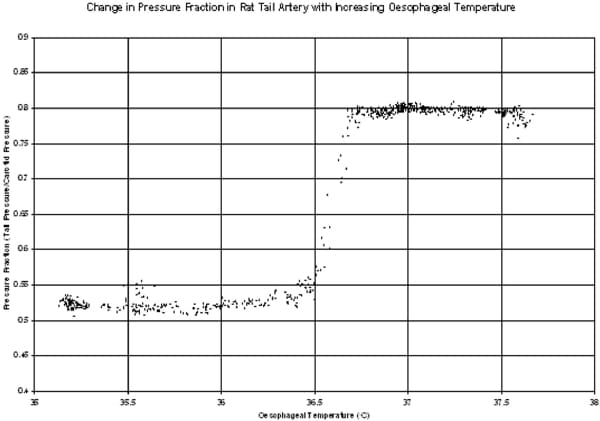An increase in body temperature of < 0.5°C caused a cessation of single unit sympathetic activity recorded focally from the rat caudal ventral tail artery (1). In contrast, population activity supplying the whole of the tail circulation ceased over a temperature range of ~2°C (2). These observations are consistent with the idea that on-off control of blood flow to different regions of the tail circulation (e.g. base and tip) has different thresholds (3) and therefore the quantal on-off (4) and the graded control hypotheses (5) are not mutually exclusive. Here we test the hypothesis that in response to an increase in body temperature the pressure within the ventral caudal artery at the base of the tail is regulated in an 'on-off' fashion. Experiments were conducted upon four urethane-anaesthetised male Sprague-Dawley rats (initial dose 1.3 g kg-1, I.P., supplemented with 5-10 mg I.V. as required) breathing spontaneously on oxygen-enriched air. Blood gases were monitored before and after a period of data collection. Oesophageal temperature (T) was monitored and regulated using a calibrated digital thermometer and a homeothermic blanket, respectively. Room temperature was 21-23°C. A jugular vein (administration of drugs and fluids) and carotid artery (to monitor ‘central’ arterial blood pressure) were cannulated. The caudal ventral artery was cannulated with the catheter tip positioned in the upper third. Oesophageal temperature was 35.0–35.5°C at the start of the protocol during which animals were heated over ~60 min to 37.5-38.0°C. Central (c) and tail (t) pressures and oesophageal temperature were monitored continuously and recorded using Spike 2 software (sampling frequency 100 Hz). Mean blood pressures were displayed (1 s moving average) and down sampled to 0.5 Hz before further processing. Pressure ratio (t/c) was plotted against oesophageal temperature. All values are mean ± S.E.M. An example of a typical plot is shown in Fig 1. On warming two stable t pressures were observed; one at ≤ 36.2 ± 0.1°C (T1) and the other at ≥ 36.4 ± 0.1°C (T2). t/c at T1 was 0.51 ± 0.01 (n=4, t = 55 ± 3mmHg, c = 108 ± 4mmHg) and t/c at T2 was 0.77 ± 0.01 (n=4, t = 75 ± 6mmHg, c = 97 ± 7mmHg). Between T1 and T2, t/c rose rapidly (gradient = 1.1 ± 0.2°C-1; linear regression analysis). These data indicate that the narrow range in temperature over which the caudal ventral artery shifts from constriction to dilatation is mediated by ‘on-off’ nervous control. We speculate that this fine control is achieved through a reduction in mean firing frequency whilst the T-rhythm is maintained (1): the latter acts to maintain fidelity of neuroeffector transmission.
University College London 2006 (2006) Proc Physiol Soc 3, PC76
Poster Communications: Rat tail artery: constriction to dilatation in less than 0.3°C
Michael P Gilbey1, Kajan Mahendran1
1. Physiology, UCL , London, United Kingdom.
View other abstracts by:
Figure 1. t/c against temperature
Where applicable, experiments conform with Society ethical requirements.

